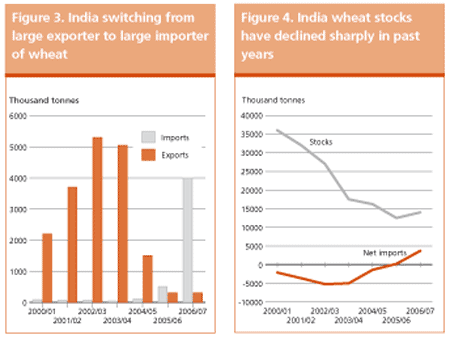No.2� �July�2006�� �July�2006�� | ||
 |
�� | Crop Prospects and Food Situation |
|
Low-Income Food-Deficit country food situation overview
In the Low-Income Food-Deficit Countries (LIFDC�s) the 2006 cereal seasons are at different stages, with crops already harvested in some regions but still to be planted in others. The overall outlook is favourable and FAO�s provisional forecast of the LIFDC�s aggregate cereal production in 2006 points to an increase of about 1.5 percent to 861.8 million tonnes. This represents a slowdown from the growth of over 4 percent in the previous year. Most of the expected increase comes from Asian countries, in particular China where production is expanding following the Government�s support policies and higher prices. When China and India are excluded, the expansion in aggregate production of the rest of LIFDC's is somewhat more modest at just 1 percent, compared to a significant growth of 8 percent in 2005. In Africa, harvest of the 2006 main season cereal crops has been completed in North and Southern Africa and outputs are estimated at record levels, fully recovering from the drought-affected crops of 2005. This improvement is likely to be offset by expected declines in Western and Eastern Africa, where crops are harvested later in the year and yields are assumed to drop from last year�s exceptional levels. In the CIS countries of Asia, another bumper cereal harvest is expected this year. In South America, a reduced cereal production is anticipated in Ecuador, the only LIFDC of the subregion, due to severe floods during the growing season. In Central America, planting of the 2006 main cereal crops has started under generally favourable growing conditions.
Early forecasts of total cereal imports by the LIFDC�s in 2006/07 indicate an increase of 2 to 3 percent from the previous season. This mainly reflects higher anticipated imports by India (Figures 3 and 4), where some 4 million tonnes of wheat are expected to be imported to replenish stocks following a reduced harvest in 2005 and low levels of opening inventories. By contrast, cereal imports (including food aid) are likely to decline sharply in Southern Africa, where much improved harvests have been gathered and export surpluses are estimated in some countries. In North Africa, imports are forecast to decline sharply in Morocco, where this year�s production is estimated to be double the drought-reduced level of 2005.  �
In Eastern, Western and Central Africa countries still in marketing year 2005/06, food aid distributions/pledges as of June 2006 remain well below the estimated requirements. In Eastern Africa, some 41 percent of the food aid needs remain uncovered, against 50 percent at the time of the previous report in April. Despite recent improved rains, food assistance is still needed for large numbers of the population in drought-affected pastoral areas of the subregion, as well as for the victims of past and renewed civil conflicts. More donors� pledges are also required for vulnerable populations in Western Africa, where 35 percent of the food aid requirements are still uncovered, particularly in Coastal countries. In the Far East, in the Democratic People�s Republic of Korea, most of the cereal imports in recent years have been in the form of food aid for chronically vulnerable people. However, against 2005/06 (November/October) estimated import requirements of 800�000 tonnes, distributions/pledges as of June 2006 amounted to only 392�000 tonnes. With the 2005/06 marketing seasons just finished in several regions, including North Africa, Southern Africa, CIS in Asia, Near East, Central and South America and in most countries in Far East, the aggregate cereal imports of the 82 Low-Income Food-Deficit countries amount to 58.8 million tonnes, or 68 percent of the estimated requirements. This estimate takes into account reports on exports from major exporters until April/May, and food aid pledges by donors as of June 2006. Actual cereal imports in 2005/06 may prove to be higher once full information on deliveries becomes available. Table 3. Cereal import position of Low-Income Food-Deficit Countries1 ( thousand tonnes)
1 For more details see Table A1 in the Statistical appendix.
2 For definition of import requirements see terminology .
3 Estimates based on reports from major exporters until April/May and food aid pledges by donors as of June 2006.
|
||||||||||||||||||||||||||||||||||||||||||||||||||||||||||||||||||||||||||||||||||||||||||||||||||||||||||||||||||||||||||||||||
�
| GIEWS | ��global information and early warning system on food and agriculture |
�
�